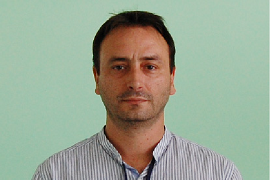Current Position
Associate Scientist at the Bioinformatics Department
The Cyprus Institute of Neurology and Genetics
Education
- 2001: BSc in Biomedical Engineering, Technological Educational Institute of Athens, Department of Biomedical Engineering, Faculty of Technological Applications
Thesis Title: Development of medical signal processing algorithms in C++ - 2003: MSc in Data Communication Systems, Brunel University London, Department of Electronic & Computer Engineering, School of Engineering & Design
Thesis Title: Development of a system for parallel processing on computer clusters for simulating the performance of scintillators used in medical imaging systems (Monte Carlo Simulation) (awarded with distinction) - 2016: PhD in Electronic & Computer Engineering, Brunel University London, Department of Electronic & Computer Engineering, School of Engineering & Design
Thesis Title: Analysis of signals related to the generation process of extreme events: towards a unified approach
(work awarded by “Vice-Chancellor’s Doctoral Research Prize”, Brunel University London, UK (2014))
(work supported by the Greek State Scholarships Foundation (IKY))
Academic Appointments:
- 2016- present: Research fellow at the Bioinformatics Group, The Cyprus Institute of Neurology and Genetics (CING). Group leader: Dr Giorgos Spyrou.
- 03/2015-09/2015: Postdoctoral Fellow at the Department of Environmental and Natural Resources Engineering, Geophysics & Seismology Laboratory
- 2004-2016: Research Assistant, Institute of Geodynamics, National Observatory of Athens, Greece, Scientific supervisor: Dr. G.A. Papadopoulos
- 2011-2016: Lab-Instructor, Technological Educational Institute of Athens, Department of Biomedical Engineering, Faculty of Technological Applications
- 2010-2011: Lab-Instructor, Technological Educational Institute of Lamia, Department of Computer Engineering
- 2003-2012: Lab-Instructor, Technological Educational Institute of Athens, Department of Electronics
- 1999-2003: Instructor, Union of Greek Physicists
Research Interests
The research directions of Dr. George Minadakis have been informed by a passion for multidisciplinary perspectives. Crossing over from statistical seismology to biomedical engineering and bioinformatics, his approach has built on and contributed to recent theoretical work suggesting common features in the generation process of extreme events, including biological ones. The employed analysis utilizes methods and metrics of scale-free statistics, graph theory, nonextensive statistical physics framework, entropic-information content and spectra-fractal methodologies, to examine issues of complexity, self-affinity, universality, self-organized and intermittent criticality, fractal structures and geometry. Dr. George Minadakis has developed several user interfaces and algorithms for real-time monitoring, mapping and analysis of multi-faced data. These include: applications (and web interfaces) on signal and image processing of geophysical, biomedical and biological data; pattern recognition algorithms and machine-learning; applications on a diverse set of statistical methods; simulation algorithms; applications for image processing and digital patient records; 2D and 3D mapping for data series observation; development of several algorithms and models for short-term prediction. In this context, his research is currently focused on Systems Bioinformatics approaches towards integration of diverse data-sets, within a unified framework of analysis that cross-fertilises and integrates the knowledge between diverse disciplines.
Biography
Dr. George Minadakis is currently a postdoctoral researcher in the Bioinformatics Group at the Cyprus Institute of Neurology and Genetics (CING). Having completed his first degree in Biomedical Engineering and his Master’s degree in Data Communication Systems, his educational background and research experience have led him to engage in multidisciplinary perspectives and expand his expertise in the study of extreme events in complex systems. He completed his PhD study at Brunel University, UK with a research project that employed a unified approach to the study of earthquake dynamics, pre-seismic electromagnetic emissions and dynamics of regional brain activity. This study has been awarded by the Vice-Chancellor’s doctoral research prize. Aiming towards an integrated approach that cross-fertilizes knowledge and methods of different disciplinary domains, Dr. George Minadakis has completed his first postdoctoral research at the School of Applied Sciences, Department of Environmental and Natural Resources Engineering, Geophysics & Seismology Laboratory, Technological Educational Institute of Crete (Greece). The accumulated research experience and scientific networking in various fields involves both independent and collaborative research in computational neuroscience, systems bioinformatics, biomedical engineering, statistical physics and seismology. Dr. George Minadakis has teaching experience since 2001, he has been involved in numerus European projects and national scientific conferences, and he also serves as a reviewer for several scientific journals.
SELECTED PUBLISHED RESEARCH MANUSCRIPTS
- Zachariou, M., Minadakis, G., Oulas, A., Afxenti, S., & Spyrou, G. M. (2018). Integrating multi-source information on a single network to detect disease-related clusters of molecular mechanisms. Journal of proteomics.
- Oulas, A., Minadakis, G., Zachariou, M., Sokratous, K., Bourdakou, M. M., & Spyrou, G. M. (2017). Systems Bioinformatics: increasing precision of computational diagnostics and therapeutics through network-based approaches. Briefings in bioinformatics.
- Daskalaki, E., Spiliotis, K., Siettos, C., Minadakis, G., and Papadopoulos, G. A. (2016). Foreshocks and short-term hazard assessment of large earthquakes using complex networks: the case of the 2009 L'Aquila earthquake, Nonlin. Processes Geophys., 23, 241-256.
- Minadakis, G., Ventouras, E., Gatzonis, S. D., Siatouni, A., Tsekou, H., Kalatzis, I., ... & Stonham, J. (2014). Dynamics of regional brain activity in epilepsy: a cross-disciplinary study on both intracranial and scalp-recorded epileptic seizures. Journal of neural engineering, 11(2), 026012.
- Eftaxias, K., Minadakis, G., Potirakis, S. M., & Balasis, G. (2013). Dynamical analogy between epileptic seizures and seismogenic electromagnetic emissions by means of nonextensive statistical mechanics. Physica A: Statistical Mechanics and its Applications, 392(3), 497-509.
- Minadakis, G., Potirakis, S. M., Stonham, J., Nomicos, C., & Eftaxias, K. (2012). The role of propagating stress waves on a geophysical scale: Evidence in terms of nonextensivity. Physica A: Statistical Mechanics and its Applications, 391(22), 5648-5657.
- Minadakis, G., Potirakis, S. M., Nomicos, C., & Eftaxias, K. (2012). Linking electromagnetic precursors with earthquake dynamics: an approach based on nonextensive fragment and self-affine asperity models. Physica A: Statistical Mechanics and its Applications, 391(6), 2232-2244.
- Papaeliou, C., Minadakis, G., & Cavouras, D. (2002). Acoustic patterns of infant vocalizations expressing emotions and communicative functions. Journal of Speech, Language, and Hearing Research, 45(2), 311-317.






0002.jpg)



